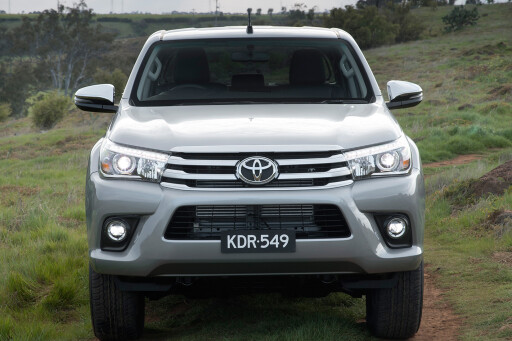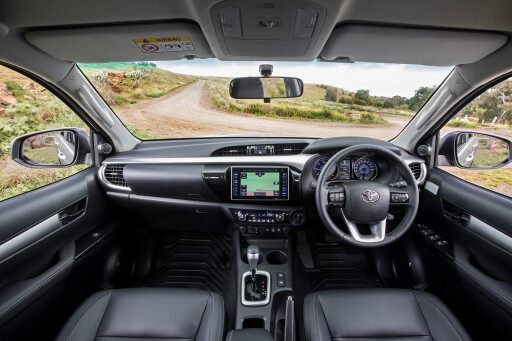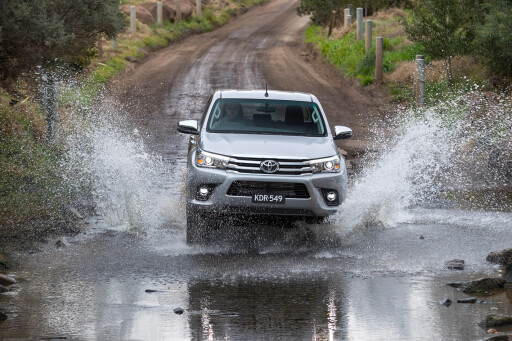
RIGHT now Toyota’s Hilux is Australia’s second bestselling 4x4.
Up until as recently as last year, and for the 11 years before that, it was Australia’s bestselling 4x4. But the Ford Ranger 4x4 has now surpassed it.
Despite the Hilux still being Australia’s number-one bestseller overall – thanks to Hilux 4x2 being well ahead of Ranger 4x2 – Toyota isn’t content. Toyota doesn’t like being ‘number two’, especially anywhere in the 4x4 market, which is its heartland and traditional stronghold.
 To address the situation Toyota has shaken up the Hilux range by introducing 10 new models, seven of them 4x4s, and increasing the number of 4x4 models in the overall mix, with 20 of the 31 Hilux variants now being 4x4.
To address the situation Toyota has shaken up the Hilux range by introducing 10 new models, seven of them 4x4s, and increasing the number of 4x4 models in the overall mix, with 20 of the 31 Hilux variants now being 4x4.
New 4x4 models include the SR+ Dual Cab, which brings alloys wheels and sat-nav in an otherwise mid-spec model, and a Workmate 2.4 automatic, previously only available as a manual.
There’s also four new Extra Cab 4x4s, three of them automatics; marking the first that an automatic transmission has been offered with the Extra Cab. All three new models in the 4x2 range are also automatic, which further highlands the shift away from manuals to automatics that this update brings.
To help make way for the new models, the 4.0-litre petrol V6 has been deleted from both the 4x4 and 4x2 range. Plus, there have been running changes to the suspension and adjustments to the equipment on a number of models.
 The SR, for example, swaps more serviceable vinyl floors for carpets and gains downhill assist; all SR5s gain LED fogs and a tailgate lock; dual-cab SR5s gain rear air cabin vents; and SR5+ models gain heated front seats to go with their leather.
The SR, for example, swaps more serviceable vinyl floors for carpets and gains downhill assist; all SR5s gain LED fogs and a tailgate lock; dual-cab SR5s gain rear air cabin vents; and SR5+ models gain heated front seats to go with their leather.
To sample the range we have driven a dual cab SR5+ (manual) for a week followed by a dual cab SR+ (automatic), again for a week. The SR+ is a significant model in the range, as the SR always looked more like a base-spec model with its black steel wheels, rather than mid-spec where it was positioned in the range.
It meant buyers wanting alloys had to move up to the top-spec SR5, which brings a less functional smooth-sided tub (no external tie-downs hooks or rails) and a chrome sportsbar instead of a more practical headboard that helps with carrying loads and protects the rear window.
Both these dual cabs, like most in the range, have new suspension dampers all ’round, which make for a more compliant and supple ride then before and further improve this new Hilux’s general road manners, which are far better than the previous generation Hilux. The softer dampers address the criticism that the previous suspension tune was too firm.
 As ever, the contrast between the six-speed automatic and the manual transmissions offered with the 2.8-litre diesel is interesting and, while the automatic is certainly the popular choice now, the manual has much to recommend it, not least being the fact it’s more economical. We recorded around 9.0L/100km for the manual and 10.0L/100km for the automatic.
As ever, the contrast between the six-speed automatic and the manual transmissions offered with the 2.8-litre diesel is interesting and, while the automatic is certainly the popular choice now, the manual has much to recommend it, not least being the fact it’s more economical. We recorded around 9.0L/100km for the manual and 10.0L/100km for the automatic.
Both the two new six-speeders have two overdrive ratios (fourth is 1:1 in both) and, while the respective fifth and sixth gears in the automatic are taller than the fifth and sixth gears in the manual, the overall gearing is similar given the manual has a taller final drive.
In both cases, “tall” is the word and, if anything, the automatic is a tad too tall for legal-speed highway driving on undulating give-and-take country roads and tends to drop from sixth to fifth and then change back up into sixth, only to repeat the process soon after, too often. If the legal open-road speed in Australia was a bit higher then all would be good, but it’s not.
 Despite the engine claiming a maximum of 420Nm with the manual and 450Nm with the automatic, the manual holds the taller gears much better, which makes it a much more enjoyable drive on country roads away from stop-start driving where the automatic is obviously still more convenient. The automatic also feels livelier in town, which may be just the gearing advantage of the torque convertor or perhaps the extra 30Nm.
Despite the engine claiming a maximum of 420Nm with the manual and 450Nm with the automatic, the manual holds the taller gears much better, which makes it a much more enjoyable drive on country roads away from stop-start driving where the automatic is obviously still more convenient. The automatic also feels livelier in town, which may be just the gearing advantage of the torque convertor or perhaps the extra 30Nm.
As ever, the 2.8 is very quiet and refined (another big difference from the previous generation Hilux), with only the Volkswagen Amarok V6 amongst its competitors bettering it in this regard. More grunt would be nice, however, as others in the class, notably Amarok V6 but also Holden Colorado, Ranger and Mazda BT-50, are more muscular, even if the Hilux is both flexible at low revs and quite willing to rev if asked.
This sliced and diced Hilux 4x4 range went on sale early in October and outsold Ranger 4x4 in that month by 322 units; although, in year-to-date sales the Hilux 4x4 is still 1655 units shy of the Ranger – a lot to make up in the remaining two months of the year. It will be an interesting run to the line.
TOYOTA HILUX SR+ DUAL CAB 4X4 SPECS:
Engine: 2.8-litre four-cylinder turbo diesel
Max power/torque: 130kW/450Nm
Gearbox: six-speed automatic
4x4 System: dual-range part-time
Kerb Weight: 2120kg
GVM: 3050kg
Payload: 930kg
Towing capacity: 3200kg
Towball download: 320kg
GCM: 5650kg
Fuel tank capacity: 80 litres
ADR fuel claim: 8.5L/100km

COMMENTS